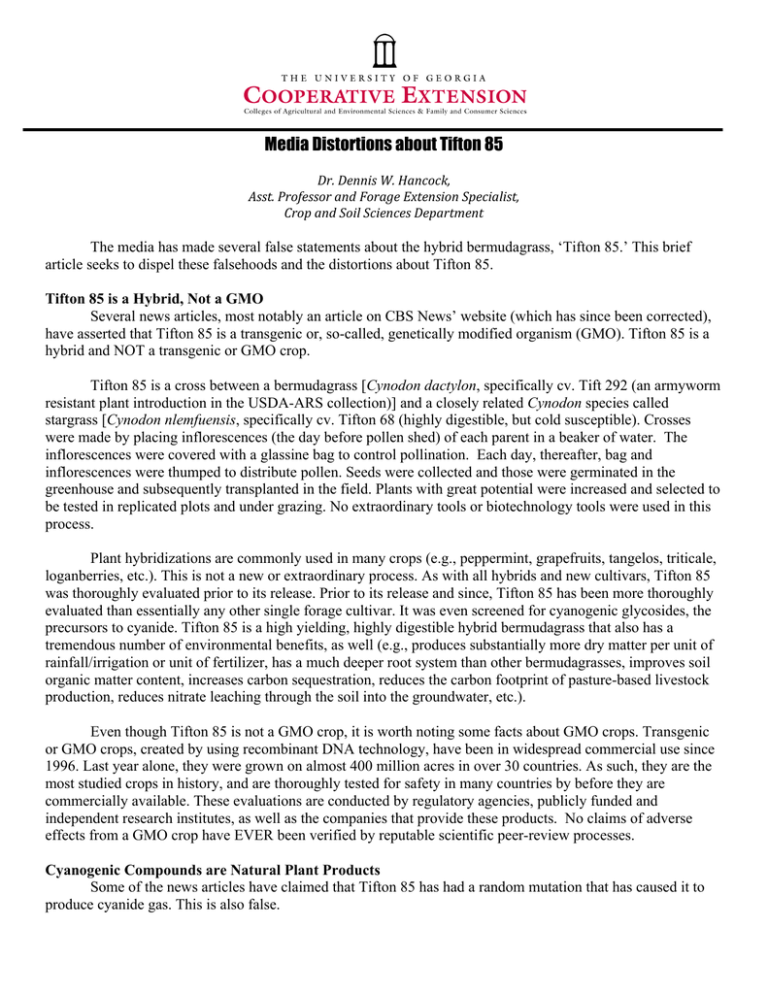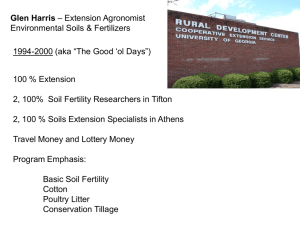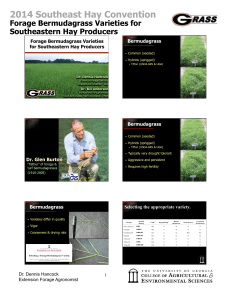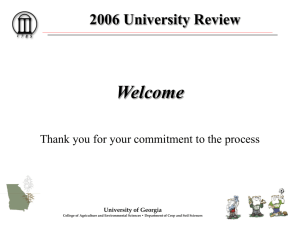Media Distortions about Tifton 85 !
advertisement

!
Media Distortions about Tifton 85
!"#$!%&&'($)#$*+&,-,./$
0((1#$2"-3%((-"$+&4$5-"+6%$781%&('-&$9:%,'+;'(1/$
<"-:$+&4$9-';$9,'%&,%($!%:+"1=%&1!
The media has made several false statements about the hybrid bermudagrass, ‘Tifton 85.’ This brief
article seeks to dispel these falsehoods and the distortions about Tifton 85.
Tifton 85 is a Hybrid, Not a GMO
Several news articles, most notably an article on CBS News’ website (which has since been corrected),
have asserted that Tifton 85 is a transgenic or, so-called, genetically modified organism (GMO). Tifton 85 is a
hybrid and NOT a transgenic or GMO crop.
Tifton 85 is a cross between a bermudagrass [Cynodon dactylon, specifically cv. Tift 292 (an armyworm
resistant plant introduction in the USDA-ARS collection)] and a closely related Cynodon species called
stargrass [Cynodon nlemfuensis, specifically cv. Tifton 68 (highly digestible, but cold susceptible). Crosses
were made by placing inflorescences (the day before pollen shed) of each parent in a beaker of water. The
inflorescences were covered with a glassine bag to control pollination. Each day, thereafter, bag and
inflorescences were thumped to distribute pollen. Seeds were collected and those were germinated in the
greenhouse and subsequently transplanted in the field. Plants with great potential were increased and selected to
be tested in replicated plots and under grazing. No extraordinary tools or biotechnology tools were used in this
process.
Plant hybridizations are commonly used in many crops (e.g., peppermint, grapefruits, tangelos, triticale,
loganberries, etc.). This is not a new or extraordinary process. As with all hybrids and new cultivars, Tifton 85
was thoroughly evaluated prior to its release. Prior to its release and since, Tifton 85 has been more thoroughly
evaluated than essentially any other single forage cultivar. It was even screened for cyanogenic glycosides, the
precursors to cyanide. Tifton 85 is a high yielding, highly digestible hybrid bermudagrass that also has a
tremendous number of environmental benefits, as well (e.g., produces substantially more dry matter per unit of
rainfall/irrigation or unit of fertilizer, has a much deeper root system than other bermudagrasses, improves soil
organic matter content, increases carbon sequestration, reduces the carbon footprint of pasture-based livestock
production, reduces nitrate leaching through the soil into the groundwater, etc.).
Even though Tifton 85 is not a GMO crop, it is worth noting some facts about GMO crops. Transgenic
or GMO crops, created by using recombinant DNA technology, have been in widespread commercial use since
1996. Last year alone, they were grown on almost 400 million acres in over 30 countries. As such, they are the
most studied crops in history, and are thoroughly tested for safety in many countries by before they are
commercially available. These evaluations are conducted by regulatory agencies, publicly funded and
independent research institutes, as well as the companies that provide these products. No claims of adverse
effects from a GMO crop have EVER been verified by reputable scientific peer-review processes.
Cyanogenic Compounds are Natural Plant Products
Some of the news articles have claimed that Tifton 85 has had a random mutation that has caused it to
produce cyanide gas. This is also false.
Some plants naturally produce compounds that are cyanogenic, or precursors to cyanide (sometimes
called prussic acid). They are present in the plants (typically) as cyanogenic glycosides or glucosinolates,
neither of which are inherently toxic in those forms. However, these compounds are readily broken down when
the plant is consumed by an herbivore or if crushed. It is a natural defense mechanism for these plants. Notable
examples of plants that produce cyanogenic compounds include common pasture and forage crops (e.g., forage
sorghum, sudangrass, white clover, etc.) and pasture weeds (e.g., Johnsongrass, black cherry trees, etc.). Certain
types of algae can also contain cyanogenic compounds, and is some cases have been implicated in cases of
poisonings from the animal’s water source. Even some fruits, vegetables, and nuts (e.g., almonds, peaches,
apples, apricots, cherries, lima beans, cassava, etc.) produce cyanogenic compounds in some of their plant
tissues (usually seeds).
These cyanogenic compounds are not normally broken down in the intact plant because the glycosides
and the enzymes that break them down are separated in different compartments. In members of the sorghum
family, for example, the cyanogenic glycoside dhurrin is present in the epidermal cells at the surface of a leaf
while the enzymes are located in the mesophyll cells in the middle of the leaf. However, when the plant is
consumed, the cyanogenic glycosides and the enzymes that break them down then come into contact and the
cyanide is released.
As previously mentioned, Tifton 85 is a hybrid of a bermudagrass and a stargrass. Some stargrass
varieties have, in very rare cases, formed cyanogenic compounds. Even so, producers in Florida have grazed
stargrass since 1972 without any incident. Stargrass has also been used in the tropics for much longer. Dairies in
Puerto Rico, for example, frequently green chop stargrass and feed it to their dairy cattle. If the risk of cyanide
poisoning was a significant problem, green chopping the forage and feeding it to dairy cattle would be a
situation that would pose the greatest risk. Even so, forage specialists and researchers at the Univ. of Puerto
Rico had never dealt with a single instance of cyanide poisoning in Puerto Rico related to stargrass.
The role (if any) that was played by Tifton 85 in the unfortunate case of the cyanide poisoning of 15
calves in Texas during late May 2012 remains unclear. The investigation is still in a preliminary stage and no
conclusions should be reached until it has been completed. Further details will emerge about this case as the
investigation continues. Until then, avoid over-reacting to this report of cyanide poisoning and rushing to
judgment about Tifton 85.
The University of Georgia and Ft. Valley State University, the U.S. Department of Agriculture and counties of the state cooperating.
Cooperative Extension, the University of Georgia College of Agricultural and Environmental Sciences, offers educational programs,
assistance and materials to all people without regard to race, color, national origin, age, gender or disability.
!
"#!$%&'(!)**+,-&#.-/!$0*(+/1,2"33.,0'-.41!"5-.+#!),6'#.7'-.+#!8+00.--19!-+!'!:.41,;1!<+,=!>+,51!
8??@>ABC!!!!!!!!!!!!!!!!!!!!!!!!!!!!!!!!!!!!!!!!!!!!!!!!!!!!!!!!!!!!!!!!!!!!!!!!!!!!!!!!!!!!!!!!!!!!!!!!!!!!!!!!!!!!!!!!!!!!!!!!!!!!!!!!!!!!!!!!!!!!!!!!!!!!!!!!!!!!!!!!!!!!!!!!!!!!
!
!
!D&#1!EACE!
Issued in furtherance of Cooperative Extension work, Acts of May 8 and June 30, 1914, The University of Georgia College of
Agricultural and Environmental Sciences and the U.S. Department of Agriculture cooperating.
J. Scott Angle, Dean and Director.







